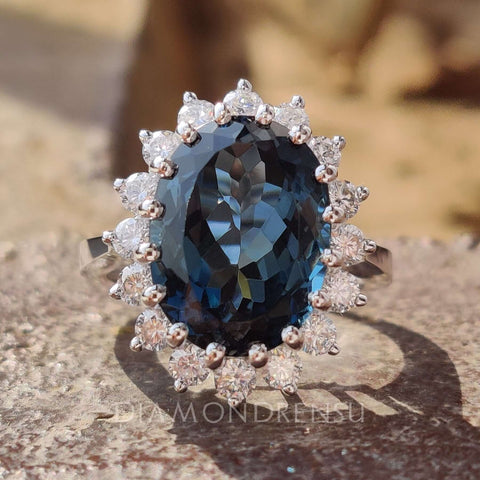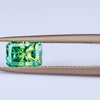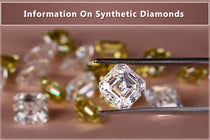Man-made diamonds, also known as synthetic or lab-grown diamonds, are identical to natural diamonds in their chemical, physical, and optical properties. These diamonds are created in controlled laboratory environments using advanced technological processes that replicate the high-pressure, high-temperature conditions under which natural diamonds form within the Earth's mantle. The main distinction between the two lies in their origin—one is unearthed from geological processes while the other is crafted by human hands.
As you explore the realm of man-made diamonds, you will come across terms such as "CVD diamonds" or "HPHT diamonds," which refer to the methodologies used to produce them—Chemical Vapor Deposition and High Pressure High Temperature, respectively. This innovation in diamond production offers you the same beauty and durability as mined diamonds, often at a more accessible price point and with fewer ethical and environmental concerns. Due to their growing popularity, man-made diamonds are becoming a favored choice for jewelry, particularly for those seeking a more sustainable option.
Understanding Man-Made Diamonds
When you hear about man-made diamonds, you're encountering the cutting-edge blend of technology and gemology. These stones rival their natural counterparts in beauty and durability.
Definition and Overview
Man-made diamonds, also referred to as synthetic or lab created diamonds, are real diamonds produced in a controlled environment as opposed to the natural geological processes. Unlike imitation gems, these created diamonds have the same physical, chemical, and optical properties as mined diamonds. The primary difference lies in their origin - man-made diamonds are cultivated in labs over weeks or months, whereas natural diamonds form over billions of years underground.
Types of Synthetic Diamonds
There are two main types of synthetic diamonds you should know about:
-
High Pressure High Temperature (HPHT) - This method mimics the natural conditions that create diamonds underground, using immense pressure and heat to transform carbon into a diamond.
-
Chemical Vapor Deposition (CVD) - CVD diamonds are grown from a hydrocarbon gas mixture, using technology that allows the carbon atoms in the gases to accumulate on a substrate, forming layers that develop into diamond crystals.
Both HPHT and CVD methods have advanced to a point where the synthetic diamonds they produce can be virtually indistinguishable from natural diamonds without professional analysis.
The Creation Process
Man-made diamonds are crafted in laboratories using advanced technological processes that mimic the conditions under which natural diamonds form. These controlled conditions allow for the transformation of carbon into stunning, crystal-clear diamonds that are optically, chemically, and physically akin to those mined from the Earth.

High Pressure High Temperature (HPHT)
The HPHT method replicates the natural diamond-growing environment by exposing carbon to high pressure and high temperature. A diamond seed is placed in carbon, typically in the form of graphite. The environment inside the HPHT machine is then set to conditions known for diamond formation: temperatures of about 1400-1600°C and pressures above 5 GPa. This process results in a crystallized diamond once the conditions are maintained for a sufficient period.

Chemical Vapor Deposition (CVD)
Alternatively, Chemical Vapor Deposition (CVD) involves a different approach to creating diamonds. In this process, you start with a thin slice of diamond seed, which is placed in a sealed chamber. The chamber is then filled with a carbon-rich gas, such as methane, and the gas is ionized into plasma using technology similar to that of microwaves or lasers. The ionization breaks down the molecular bonds in the gases, and pure carbon adheres to the diamond seed. The carbon atoms gradually build up in layers, forming a diamond. CVD operates at relatively lower temperatures compared to HPHT—about 700-1000°C—and does not require the same extreme pressures.
Comparing Lab-Grown and Natural Diamonds

| Characteristic | Lab-Grown Diamonds | Natural Diamonds |
|---|---|---|
| Formation | Created in a laboratory setting | Naturally formed deep within the Earth over millions of years |
| Cost | Generally more affordable than natural diamonds | Varies based on cut, carat, color, and clarity |
| Quality | Can have fewer inclusions and may be of consistent quality | Natural variations in quality; may have inclusions |
| Environmental Impact | May have a lower environmental impact compared to mining | Mined diamonds have environmental considerations |
| Certification | Certified as lab-grown diamonds | Certified based on natural origin |
| Market Acceptance | Gaining acceptance in the market | Traditional and widely accepted |
In your quest to understand diamonds, it's crucial to recognize that while both lab-grown and natural diamonds hold their own appeal, they share many similarities and yet differ in key aspects.
Physical and Optical Characteristics
Lab-grown and natural diamonds exhibit identical physical and optical properties to the naked eye; they both refract light spectacularly, creating that brilliance and fire which are so prized. The hardness of both diamond types is the same, each scoring a perfect 10 on the Mohs scale, making them the hardest known minerals on Earth. Your lab-grown diamond and a natural counterpart will both scratch anything else—and not get scratched in return.
Chemical and Structural Composition
Chemically, mined diamonds and their lab-grown analogues are made of the same building blocks: pure carbon, arranged in a crystal lattice structure that imparts both types of diamonds with their renowned durability. However, synthetic diamonds do not generally come with the same types of impurities or inclusions found in natural diamonds, which are remnants of their formation deep within the Earth. This difference under a microscope serves as a marker to differentiate between a diamond made by nature and one crafted in a lab.
Quality and Grading

In the realm of man-made diamonds, your understanding of quality and grading is essential. These lab-created gems are evaluated much like their natural counterparts, focusing on the Four Cs—clarity, color, cut, and carat weight—which directly influence their value and appeal.
The Four Cs
Clarity refers to the absence of inclusions and blemishes. Man-made diamonds, although created in controlled conditions, can exhibit such imperfections, similar to natural diamonds. Color in man-made diamonds ranges from colorless to various tints, which are graded on a scale from D (colorless) to Z (light color). Cut is about how well the diamond has been shaped from its rough form and includes aspects of proportion, symmetry, and polish, affecting the stone's brilliance. Carat weight simply measures a diamond's weight, with one carat being equivalent to 200 milligrams.
Grading Certifications
When you own a man-made diamond, ensure it comes with a grading report, also known as a certification. Renowned entities like the Gemological Institute of America (GIA) provide certifications outlining a diamond's attributes based on the Four Cs. This certification confirms the authenticity and quality of your man-made diamond, giving you confidence in your investment.
Market Analysis
In this section, you'll discover how man-made diamonds stand in the market through an examination of their prices compared to natural diamonds and the current consumer demand and trends that shape the industry.
Price Comparisons
Man-made diamonds offer an affordable alternative to natural diamonds. Typically, you can expect these engineered stones to cost 20-40% less than their natural counterparts. This price variance depends on factors such as the size, color, cut, and clarity of the diamond.
Price of Natural vs. Man-made Diamonds:
| Carat | Man-made Diamond | Natural Diamond |
|---|---|---|
| 0.50 | $500 - $1,000 | $1,000 - $2,000 |
| 1.00 | $1,000 - $3,000 | $4,000 - $6,000 |
| 1.50 | $2,000 - $4,500 | $6,000 - $9,000 |
Prices are approximate and can vary.
Consumer Demand and Trends
You are witnessing a shift in the diamond jewelry market. Consumer preference is increasingly leaning towards man-made diamonds. The trends show that the modern buyer prioritizes ethical sourcing and environmentally friendly options. Man-made diamonds fit this ethos well since they require less mining and have a smaller ecological footprint. This shift is also driven by the fact that man-made diamonds offer a high-quality alternative that is more accessible due to its affordability.
Recent studies, such as those by General Electric Research, indicate growing market acceptance, with consumers preferring the term 'man-made' as it underscores the ethical creation of these stones. The demand for man-made diamonds is projected to steadily increase as awareness and education about their benefits continue to permeate the market.
Environmental and Ethical Considerations

When you explore the world of diamonds, it's crucial to consider not only the sparkle but also the sustainability and morality behind their creation. Manufactured diamonds offer a compelling alternative to traditional mining, addressing some of the ecological and ethical challenges associated with the diamond industry.
Ecological Impact of Diamond Mining
Diamond mining has a significant ecological footprint. The extraction processes often lead to large open pits and disruption of ecosystems. You may be familiar with the term "blood diamond," which refers to stones mined in conflict areas where the sale proceeds finance war and human rights abuses. But beyond the social impact, mining can lead to soil erosion, deforestation, and habitat destruction. In contrast, manufactured diamonds are created in a lab setting, dramatically reducing the environmental degradation typically associated with natural diamond mining.
Ethical Sources and Practices
When evaluating diamonds, ethical considerations are paramount. Ethical sourcing means ensuring that the diamonds are conflict-free and that the practices involved in procuring them adhere to strict labor and environmental standards. The rise of manufactured diamonds has been driven by a desire to offer consumers ethical choices. These lab-created diamonds circumvent the issues of funding conflict and exploiting workers which have plagued certain sectors of the diamond market. By choosing manufactured diamonds, you’re not only buying a symbol of luxury but also supporting a more ethical practice in the gemstone industry.
Choosing a Man-Made Diamond

When you're in the market for a man-made diamond, your key considerations should revolve around assessing the quality and price to ensure that you're getting the best value for your money. It's equally crucial to select the right vendor that not only guarantees authenticity but also offers a transparent purchasing process.
Evaluating Quality and Price
-
Quality: Look for certification from reputable labs such as the Gemological Institute of America (GIA) to ensure your diamond meets industry standards.
-
Price: Compare prices across various vendors to find a competitive price tag. Remember, the cost of man-made diamonds is typically lower than natural diamonds without compromising on the dazzle.
Advice: Always ask for a detailed breakdown of a diamond's characteristics, which include its cut, color, clarity, and carat weight—these will have the most significant influence on the price.
Selecting the Right Vendor
-
Reputation: Identify vendors such as James Allen or De Beers, known for their high-quality man-made diamonds.
-
Transparency: The vendor should provide comprehensive information about each diamond's origin and manufacturing process.
Checklist for Vendor Selection:
- Comprehensive certification and documentation
- Positive customer reviews and testimonials
- Detailed online product descriptions and images
- Customer-friendly return and warranty policies
Tip: It's beneficial to research and select a vendor that aligns closely with your specific requirements and offers a seamless and trustworthy customer experience.
Final Thoughts
In determining the right choice between man-made diamonds and their natural counterparts, your personal taste and financial considerations play crucial roles.
Personal Preferences
Man-made diamonds, also referred to as lab-grown or synthetic diamonds, cater to a range of personal preferences with their ethical production and lower cost. They mirror the aesthetics of natural diamonds so closely that distinguishing between them without expert analysis can be challenging. The decision often aligns with your values—whether you prioritize environmental sustainability or cherish the allure of a gem formed over millennia.
Investment and Resale Value
When it comes to investment and resale value, natural diamonds typically hold their value over time better than synthetic ones. This is due to their rarity and established market value. However, if your budget is more modest, lab-grown diamonds offer larger stones for the same price. Keep in mind that while the initial outlay may be lower, the resale market for man-made diamonds is still maturing. If you view your purchase as a long-term investment, consider the sentimental value over the potential financial return.
Frequently Asked Questions
When considering the world of diamonds, it's essential to understand the specifics about man-made options, including their composition, cost, value, and appearance. Let's address some common inquiries you might have.
What distinguishes lab-grown diamonds from natural diamonds?
Lab-grown diamonds are created in controlled environments using advanced technological processes that replicate the conditions under which natural diamonds form. While they share the same chemical and physical properties, lab-grown diamonds are crafted by humans over a shorter period, as explained in a report by General Electric.
Can you compare the price and quality of moissanite against lab-created diamonds?
Moissanite generally costs less than lab-created diamonds and possesses nearly comparable hardness and brilliance, making it a budget-friendly alternative. For a detailed comparison, including their optical qualities, you might consider reading a progress report on man-made diamonds that provides in-depth insights on the subject.
What are the pros and cons of choosing moissanite over a diamond?
Moissanite is more affordable and nearly as durable as diamonds, offering high resistance to scratching and breaking. However, it has a distinct refractive index, which gives it a different sparkle and, to the discerning eye, can be visually distinguished from diamond.
Is there a significant cost difference between lab-grown diamonds and moissanite?
Yes, moissanite is often significantly less expensive than lab-grown diamonds. This price disparity is due to differences in material rarity and the production processes involved.
How does the long-term value of man-made diamonds compare to that of natural diamonds?
Man-made diamonds typically depreciate more compared to natural diamonds, which tend to retain or sometimes increase in value over time. This difference is largely due to the perception and demand in the marketplace.
Are there visible differences between moissanite and lab diamonds when viewed side by side?
To an untrained observer, moissanite and lab diamonds may appear quite similar, but upon closer inspection, differences in brilliance and fire can be observed. Moissanite tends to display more colorful refracted light compared to the more subdued sparkle of a lab diamond.
Checkout some of our top collections:











